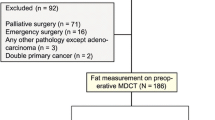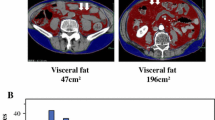Abstract
Background
The relationship between fat distribution and lymph node metastasis has not been well studied. The goal of this study was to determine the impact of visceral obesity on lymph node metastasis in gastric cancer.
Materials and Methods
Metastatic lymph node ratio (MLR) was defined as the number of involved nodes by tumor divided by the total number of resected lymph nodes. Visceral (VFA) and subcutaneous fat areas (SFA) were determined by measuring abdominal fat volume distribution via CT scan, and visceral obesity was defined as a VFA to total fat area ratio (V/T) >0.29.
Results
With lymph node metastasis as a dependent variable, the following factors were significant in multivariate analysis among 495 patients: pathologic T stage (P < 0.001), lympho-vascular invasion (P < 0.001), and V/T (hazard ratio (HR) = 0.455, 95 % confidence interval (CI) = 0.263–0.786, P = 0.005). Similarly, when MLR was the dependent variable in multivariate analysis, MLR was significantly associated with lympho-vascular invasion (HR = 2.222, 95 % CI = 1.149–4.296, P = 0.018), and V/T (HR = 0.247, 95 % CI = 0.133–0.458, P < 0.001).
Conclusions
Visceral obesity defined by higher visceral to total fat area ratio was significantly associated with decreased MLR.


Similar content being viewed by others
References
Yang P, Zhou Y, Chen B, et al. Overweight, obesity and gastric cancer risk: results from a meta-analysis of cohort studies. Eur J Cancer 2009;45:2867–73.
Kubo A, Corley DA. Body mass index and adenocarcinomas of the esophagus or gastric cardia: a systematic review and meta-analysis. Cancer Epidemiol Biomarkers Prev 2006;15:872–8.
Engeland A, Tretli S, Bjorge T. Height and body mass index in relation to esophageal cancer; 23-year follow-up of two million Norwegian men and women. Cancer Causes Control 2004;15:837–43.
Machova L, Cizek L, Horakova D, et al. Association between obesity and cancer incidence in the population of the District Sumperk, Czech Republic. Onkologie 2007;30:538–42.
Rousseau MC, Parent ME, Siemiatycki J. Comparison of self-reported height and weight by cancer type among men from Montreal, Canada. Eur J Cancer Prev 2005;14:431–8.
Corley DA, Kubo A, Zhao W. Abdominal obesity and the risk of esophageal and gastric cardia carcinomas. Cancer Epidemiol Biomarkers Prev 2008;17:352–8.
Carr DB, Utzschneider KM, Hull RL, et al. Intra-abdominal fat is a major determinant of the National Cholesterol Education Program Adult Treatment Panel III criteria for the metabolic syndrome. Diabetes 2004;53:2087–94.
Preis SR, Massaro JM, Robins SJ, et al. Abdominal subcutaneous and visceral adipose tissue and insulin resistance in the Framingham heart study. Obesity (Silver Spring) 2010;18:2191–8.
Sandeep S, Gokulakrishnan K, Velmurugan K, et al. Visceral & subcutaneous abdominal fat in relation to insulin resistance & metabolic syndrome in non-diabetic south Indians. Indian J Med Res 2010;131:629–35.
Dieudonne MN, Bussiere M, Dos Santos E, et al. Adiponectin mediates antiproliferative and apoptotic responses in human MCF7 breast cancer cells. Biochem Biophys Res Commun 2006;345:271–9.
Renehan AG, Zwahlen M, Minder C, et al. Insulin-like growth factor (IGF)-I, IGF binding protein-3, and cancer risk: systematic review and meta-regression analysis. Lancet 2004;363:1346–53.
Yu JW, Wu JG, Zheng LH, et al. Influencing factors and clinical significance of the metastatic lymph nodes ratio in gastric adenocarcinoma. J Exp Clin Cancer Res 2009;28:55.
Marchet A, Mocellin S, Ambrosi A, et al. The ratio between metastatic and examined lymph nodes (N ratio) is an independent prognostic factor in gastric cancer regardless of the type of lymphadenectomy: results from an Italian multicentric study in 1853 patients. Ann Surg 2007;245:543–52.
Yoshizumi T, Nakamura T, Yamane M, et al. Abdominal fat: standardized technique for measurement at CT. Radiology 1999;211:283–6.
Kaess BM, Pedley A, Massaro JM, et al. The ratio of visceral to subcutaneous fat, a metric of body fat distribution, is a unique correlate of cardiometabolic risk. Diabetologia 2012;55:2622–30.
Pickhardt PJ, Jee Y, O'Connor SD, del Rio AM. Visceral adiposity and hepatic steatosis at abdominal CT: association with the metabolic syndrome. AJR Am J Roentgenol 2012;198:1100–7.
Siewert JR, Bottcher K, Stein HJ, Roder JD. Relevant prognostic factors in gastric cancer: 10-year results of the German Gastric Cancer Study. Ann Surg 1998;228:449–61.
Olefsky JM, Glass CK. Macrophages, inflammation, and insulin resistance. Annu Rev Physiol 2010;72:219–46.
Morris PG, Hudis CA, Giri D, et al. Inflammation and increased aromatase expression occur in the breast tissue of obese women with breast cancer. Cancer Prev Res (Phila) 2011;4:1021–9.
Kulig J, Sierzega M, Kolodziejczyk P, et al. Implications of overweight in gastric cancer: A multicenter study in a Western patient population. Eur J Surg Oncol 2010;36:969–76.
Porter GA, Inglis KM, Wood LA, Veugelers PJ. Effect of obesity on presentation of breast cancer. Ann Surg Oncol 2006;13:327–32.
Deglise C, Bouchardy C, Burri M, et al. Impact of obesity on diagnosis and treatment of breast cancer. Breast Cancer Res Treat 2010;120:185–93.
Tokunaga M, Hiki N, Fukunaga T, et al. Better 5-year survival rate following curative gastrectomy in overweight patients. Ann Surg Oncol 2009;16:3245–51.
Tsujinaka T, Sasako M, Yamamoto S, et al. Influence of overweight on surgical complications for gastric cancer: results from a randomized control trial comparing D2 and extended para-aortic D3 lymphadenectomy (JCOG9501). Ann Surg Oncol 2007;14:355–61.
Hiki N, Fukunaga T, Yamaguchi T, et al. Increased fat content and body shape have little effect on the accuracy of lymph node retrieval and blood loss in laparoscopic distal gastrectomy for gastric cancer. J Gastrointest Surg 2009;13:626–33.
Sun Z, Zhu GL, Lu C, et al. The impact of N-ratio in minimizing stage migration phenomenon in gastric cancer patients with insufficient number or level of lymph node retrieved: results from a Chinese mono-institutional study in 2159 patients. Ann Oncol 2009;20:897–905.
Fukuda N, Sugiyama Y, Midorikawa A, Mushiake H. Prognostic significance of the metastatic lymph node ratio in gastric cancer patients. World J Surg 2009;33:2378–82.
Ren G, Cai R, Zhang WJ, et al. Prediction of risk factors for lymph node metastasis in early gastric cancer. World J Gastroenterol 2013;19:3096–107.
Pantel K, Brakenhoff RH. Dissecting the metastatic cascade. Nat Rev Cancer 2004;4:448–56.
Author Contributions
Hang Lak Lee and Se Woo Park were responsible for the study conception and design. Se Woo Park and Eun Young Doo contributed to the acquisition of data. Se Woo Park and Hang Lak Lee did the analysis and interpretation of data. Se Woo Park, Dae Won Jun, Oh Young Lee, Dong Soo Han, Byung Chul Yoon, Ho Soon Choi, and Joon Soo Hahm contributed to the drafting of the manuscript. Se Woo Park and Hang Lak Lee revised the manuscript. Hang Lak Lee and Se Woo Park supervised the study and did the final approval.
Conflict of Interest
The authors have no potential conflicts of interest. The authors alone are responsible for the content and writing of the paper.
Author information
Authors and Affiliations
Corresponding author
Rights and permissions
About this article
Cite this article
Park, S.W., Lee, H.L., Ju, Y.W. et al. Inverse Association Between Visceral Obesity and Lymph Node Metastasis in Gastric Cancer. J Gastrointest Surg 19, 242–250 (2015). https://doi.org/10.1007/s11605-014-2682-2
Received:
Accepted:
Published:
Issue Date:
DOI: https://doi.org/10.1007/s11605-014-2682-2




